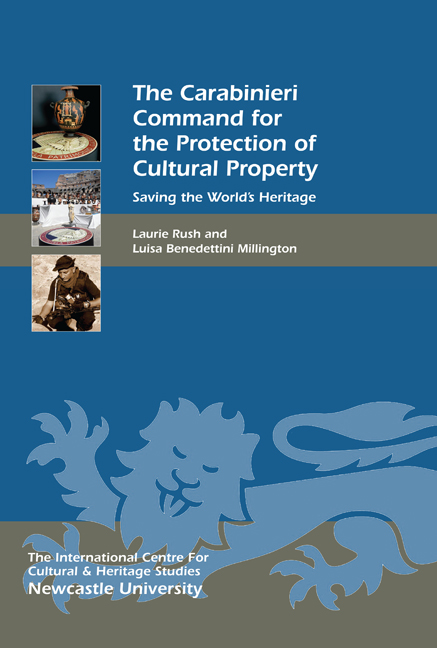Book contents
- Frontmatter
- Contents
- List of Illustrations
- Acknowledgments
- Foreword (in English and in Italian): Brigadier General Mariano Mossa
- Prefazione
- Abbreviations
- 1 The Carabinieri TPC: an Introduction and Brief History. Perché l’Italia? Why Italy?
- 2 Headquarters, the Databank and Operative Department in Rome
- 3 Carabinieri Public Outreach and Education
- 4 Central Italy and the Adriatic: Lazio, Florence, Bologna and Ancona
- 5 Activities in the North: Genova, Monza, Torino and Venezia
- 6 The Regional Offices: Naples, Bari and the South
- 7 The Challenges of the Island Regions: Sicily, Sardinia and the Palermo, Siracusa and Sassari Nuclei
- 8 Investigation Techniques
- 9 Repatriation of Works of Art to Italy: From Siviero to the Medici Conspiracy
- 10 Fakes, Forgeries and Money Laundering
- 11 Who Are the Officers of the Carabinieri TPC?
- 12 The Carabinieri, Peacekeeping and Foreign Relations: The Carabinieri Mission to Iraq
- 13 ‘The Italian Model’
- Bibliography and References
- About the Authors
- Index
- Heritage Matters
4 - Central Italy and the Adriatic: Lazio, Florence, Bologna and Ancona
Published online by Cambridge University Press: 21 May 2021
- Frontmatter
- Contents
- List of Illustrations
- Acknowledgments
- Foreword (in English and in Italian): Brigadier General Mariano Mossa
- Prefazione
- Abbreviations
- 1 The Carabinieri TPC: an Introduction and Brief History. Perché l’Italia? Why Italy?
- 2 Headquarters, the Databank and Operative Department in Rome
- 3 Carabinieri Public Outreach and Education
- 4 Central Italy and the Adriatic: Lazio, Florence, Bologna and Ancona
- 5 Activities in the North: Genova, Monza, Torino and Venezia
- 6 The Regional Offices: Naples, Bari and the South
- 7 The Challenges of the Island Regions: Sicily, Sardinia and the Palermo, Siracusa and Sassari Nuclei
- 8 Investigation Techniques
- 9 Repatriation of Works of Art to Italy: From Siviero to the Medici Conspiracy
- 10 Fakes, Forgeries and Money Laundering
- 11 Who Are the Officers of the Carabinieri TPC?
- 12 The Carabinieri, Peacekeeping and Foreign Relations: The Carabinieri Mission to Iraq
- 13 ‘The Italian Model’
- Bibliography and References
- About the Authors
- Index
- Heritage Matters
Summary
INTRODUCTION
This chapter reviews Carabinieri TPC operations at the regional level and offers an opportunity to examine cultural property protection responsibilities and priorities, as they vary owing to regional culture and types of resources.
ROME AS A REGIONAL OFFICE
The TPC headquarters in Rome serves as the de factoregional office for the provinces of Lazio and Abruzzo and is also in charge of carrying out investigations of particular importance throughout the Italian territory. A particular challenge associated with the Lazio province is the protection of portions of ancient Etruscan land, including the necropoli of Banditaccia at Cerveteri and Monterozzi at Tarquinia, both properties on the UNESCO World Heritage List (see Fig 4.2).
Both modern communities lay foundations, literally and figuratively, on those of their Etruscan ancestors and have, for generations, had knowledge of the ancient tombs and treasures. Wealthy Etruscans wanted to be sure that they would enter eternity in comfort. Etruscan families built elaborate tombs, sometimes with multiple rooms, featuring wall paintings and filled with extraordinary objects. Remains of family members were placed in elegantly carved sarcophagi. The Sarcophagus of the Spouses, from the Etruscan tombs at Cerveteri and now on exhibit at Villa Giulia in Rome, is one of the most moving and well-known objects from all of antiquity. In addition to sarcophagi, Etruscan tombs featured a wide range of objects considered useful in the afterlife: weapons, chariots, works of art, statuettes, items for personal grooming, home furnishings and even stylised hands and spheres, combined to make human images that also resided in the tombs. One result of these practices was that the ancient Etruscans left the countryside filled with remarkable structures full of unbelievable quantities of treasure.
Unfortunately, along with a heritage ethic, tombaroliand a culture of looting also emerged throughout the region. As the two communities of Tarquinia and Cerveteri have responded in different ways to the buried resources surrounding them, they offer contrasting examples that help us to understand the factors that contribute to preservation success. Marín-Aguilera (2012, 572–5) points out that the city of Tarquinia developed a tourism economy based on the heritage. The original walled city and its medieval quarters welcome tourists in great number to museums, shops and restaurants.
- Type
- Chapter
- Information
- The Carabinieri Command for the Protection of Cultural PropertySaving the World's Heritage, pp. 53 - 68Publisher: Boydell & BrewerPrint publication year: 2015



